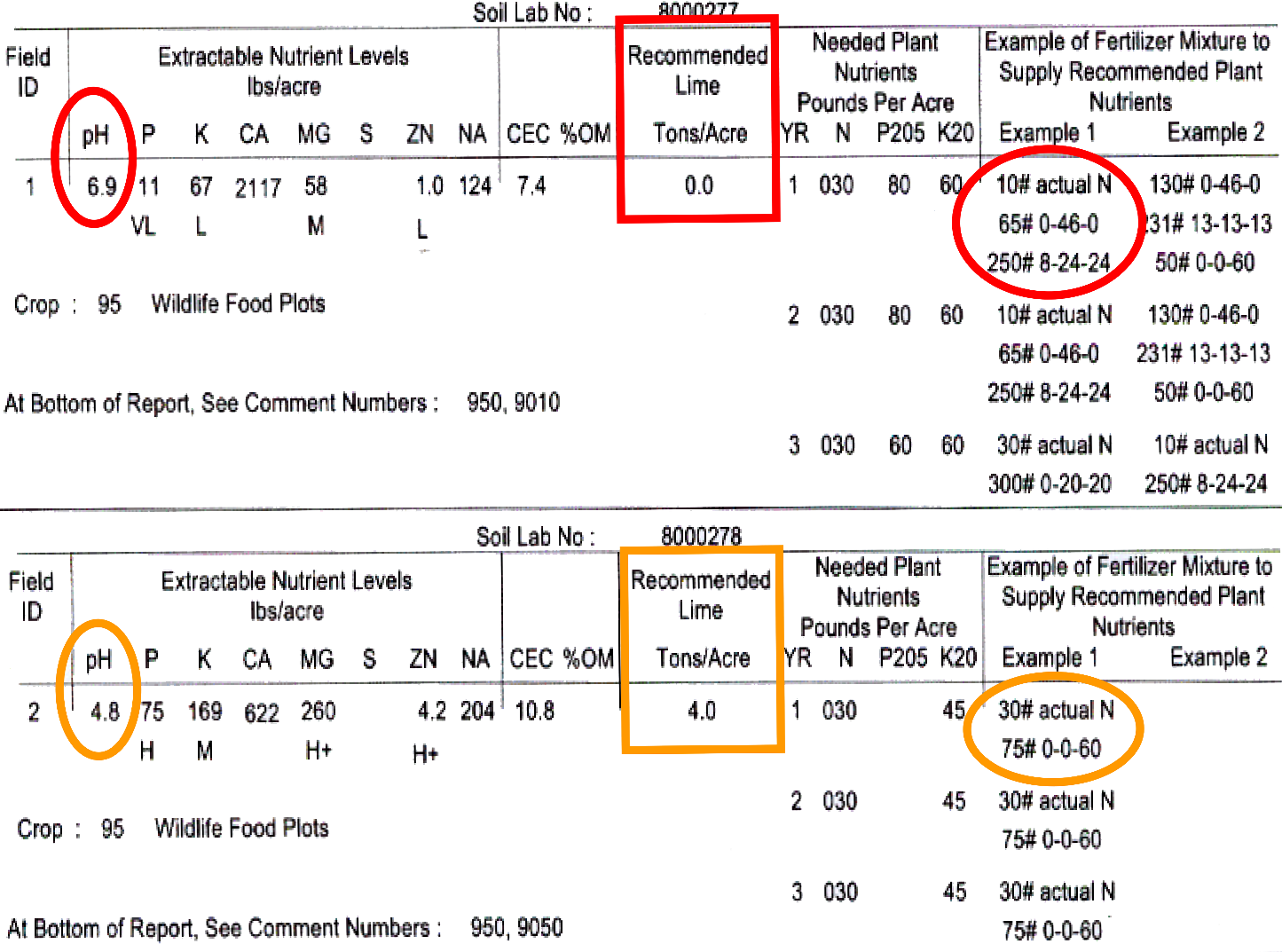Getting the Most Bang for Your Buck: A Guide for Liming and Fertilizing Wildlife Food Plots

Every spring and fall, Mississippi hunters take to the field to plant food plots for deer and other wildlife. Food plots have become a very common management practice for game species—and for good reason. A well-managed food plot can generate thousands of pounds of high-quality forage throughout the year. Research has shown time and time again that nutrition is the key for improving deer quality.
Often, hunters neglect the most simple, but productive, step when preparing a food plot—taking a soil test. The Mississippi State University Extension Service provides a soil test for the minimal cost of $8. Make no mistake—this is the best money you can spend on your food plot. The information provided from a routine soil test is critical to maximizing forage growth, and it can even save you money! Rather than simply applying a general fertilizer at planting, you can provide the correct amounts of nutrients needed for specific forages. What’s more, if the soil pH is low (below 6.0), a significant portion of the fertilizer cannot be used by the forage, which means you’re wasting money. This publication emphasizes the importance of using lime and proper fertilizer to adjust soil pH and improve food plot performance.
Soils in Mississippi are typically acidic in nature. Excess soil acidity can constrain soil productivity for wildlife food plots. Benefits from liming food plots include: improved soil properties (physical, chemical, and biological); increased available plant nutrients; increased symbiotic nitrogen (N) fixation by legumes; and increased uptake of calcium (Ca), magnesium (Mg), and other minerals. Therefore, properly using lime is one of the single-most important inputs in successful wildlife food plot management.
Lime increases the cation exchange capacity (CEC), thereby reducing leaching losses of nutrients such as potassium (K), Ca, and Mg. Lime also improves soil aggregation and tilth, resulting in greater root penetration and proliferation, and it can increase symbiotic bacteria populations in the soil. Optimum pH favors early and effective nodulation, which is important for clovers, peas, soybeans, and other legumes that may be in wildlife seed mixtures. When soil pH is optimum, grasses and legumes develop extensive root systems that facilitate better uptake and use of soil nutrients and water.
|
Treatment |
Biomass (lb/ac) |
Crude Protein |
|---|---|---|
|
Control |
1083.25 |
13.9 |
|
Fertilizer |
1392.25 |
15.45 |
|
Lime |
1443.25 |
15.56 |
|
Lime and Fertilizer |
1525.5 |
16.83 |
Soil nutrients that are essential for plants are often not available if the pH is acidic. Adding lime will neutralize soil acidity and improve nutrient availability. With many liming materials available, choosing the right one can be difficult. Consumers have many choices: ground or dug agriculture lime (aglime), pelletized “quick” lime, and liquids or suspensions that can be sprayed on the soil surface to raise pH.
Mississippi State University Extension Service Soil Testing Laboratory lime recommendations are based on a lime material that has a 100 percent relative neutralizing value (RNV). Therefore, if the lime is less than 100 percent—and most lime materials are—more lime is needed to meet the recommended amount. For example, 3 tons of lime material with a 67 percent RNV is required to neutralize an acre of soil, whereas only 2 tons of lime material with a 100 percent RNV would be needed to neutralize that same acre of soil.
The relative neutralizing value of lime material is based on calcium carbonate equivalent (CCE) and particle size distribution of the material. The higher the CCE and the greater the mesh sieve size, the greater the relative neutralizing value of the lime material will be. Always check relative neutralizing value of the lime material before determining the amount of the lime needed. This can also be used to compare the cost of liming materials. A larger quantity of low-cost lime material may be
less expensive than a smaller quantity of high-quality lime.
Several factors affect whether or not you choose bulk, pelletized, or liquid lime. Pelletized and liquid lime materials are formed from bulk aglime. Very fine lime materials are pelletized or liquidized, which may neutralize the soil faster, but the cost of these products will likely be much greater. As a result, these products may not be cost-effective for food plots covering several acres. Pelletized and liquid lime materials are products hunters can use for small plots or areas impossible to reach with a spreader truck. Food plots where pelletized or liquid limes have been used may require more frequent soil sampling because reduced amounts are applied and soil pH is not maintained. If a hunting lease is a year-to-year agreement, you may choose to apply pelletized or liquid lime to forgo the bulk aglime application.
Bulk aglime has both fine and coarse particles. Fine particles will react and change the soil pH first. Then, the coarser particles will dissolve slowly and maintain the soil pH for a longer period of time. Aglime, including bulk aglime, is generally less
expensive than pelletized or liquid lime, but a spreader truck is typically required. For food plots 1 acre or larger, bulk aglime would be far more cost-effective than pelletized or liquid products. Some acidic soils could require several tons of lime per acre for neutralization. If a soil requires 4 tons of lime or more per acre, it is recommended that another soil sample be taken the following year to ensure the soil pH has adjusted or to determine if more lime is needed.
Following are example calculations of liquid, pelletized, and bulk lime products needed for a 1-ton-per-acre recommendation from soil test results.
Liquid Lime Product
- Adjust for RNV of liquid lime product:
100 / 95 × 1 ton = 1.05 ton per acre
- Convert to pounds of liquid lime product:
1.05 × 2,000 pounds = 2,100 pounds per acre
- Calculate total gallons of liquid lime product needed:
Liquid lime product = 15.09 pounds per gallon
2,100 / 15.09 = 139 gallons per acre
- Calculate cost:
Cost is $54 per case, which holds 5 gallons
139 / 5 = 27.8 (or 28) cases
$54 × 28 = $1,512 per acre
Pelletized Lime Product
- Adjust for RNV of pelletized lime:
100 / 90 × 1 ton = 1.11 ton per acre
- Convert to pounds of pelletized lime:
1.11 × 2,000 pounds = 2,222 pounds per acre
- Calculate total pounds of pelletized lime needed:
Pelletized lime bag = 40 pounds
- Calculate cost:
Cost is $3.75 per bag
$3.75 × 56 = $210 per acre
Bulk Aglime Product
- Adjust for RNV of Aglime:
100 / 65 × 1 ton = 1.54 ton per acre
- Calculate total pounds of Aglime needed:
1.54 × 2,000 pounds = 3,080 pounds per acre
- Calculate cost:
Cost is $53 per ton
$53 × 1.54 ton = $81.62 per acre

There is an expense when liming or fertilizing wildlife food plots, so choose wisely. The expense of spreading the products was not figured into the cost per acre. The less material applied, the more frequent soil sampling is recommended. The liquid and pelletized lime products have higher RNV and are easier to apply, but to get the same neutralizing effect over time, the products are more expensive. These are often sold with the pitch of using less total product. However, more applications have to be made and more often.
The MSU Extension Soil Testing Laboratory’s routine analysis for wildlife food plot soil samples includes: pH; buffer pH (total acidity of soil), which helps determine the lime recommendation; and phosphorus, potassium, calcium, magnesium, sodium, and zinc needs. Based on these tests, the report will recommend levels of nitrogen, phosphorus, and potassium needed for specific sites. In addition, a soil test will provide a lime recommendation for acidic soils.
Proper collection of a soil sample is extremely important to ensure reliable recommendations. Remember, the results are only as good as the sample taken. To collect a proper sample, take several sub-samples from throughout the field and mix them together to obtain an average for the entire area. For example, if you plan to establish a 1- to 10-acre wildlife food plot, collect and combine 10 to 12 sub-samples into a single sample to represent the field. Sub-samples should be collected from the top layer of soil, 0–6 inches in depth. Mix the sub-samples together to form a uniform sample, and discard any plant material that might have been collected.
Crop code 95 should be used for any wildlife seed mixtures (wheat, oats, clovers, rye, brassicas, etc.). For the most effective results, take a soil sample on the first establishment and one every 2 years on existing food plots. Samples may be sent directly to the MSU Extension Soil Testing Laboratory at the address below, or you may take them to your local county Extension office. Be sure to include submission form 76 and a check or money order with the package. Label and tightly secure the shipping container.
Ship packages to:
MSU Extension Soil Testing Laboratory
190 Bost North
Mississippi State, MS 39762
Contact your local county Extension office or visit extension.ms1state.edu for more information on taking soil samples, shipping samples to the Soil Testing Laboratory, and the different grass and legume species for wildlife food plots.
References
Aglime Facts Publication Potash & Phosphate Institute (PPI)
Foundation for Agronomic Research (RAR)
National Stone Association (NSA)
The information given here is for educational purposes only. References to commercial products, trade names, or suppliers are made with the understanding that no endorsement is implied and that no discrimination against other products or suppliers is intended.
Publication 3102 (POD-09-23)
By Bronson Strickland, PhD, Extension Professor, Wildlife, Fisheries, and Aquaculture; K. Keith Crouse, PhD, Associate Extension Professor (retired), Plant and Soil Sciences; and Bill Hamrick, Senior Extension Associate, Wildlife, Fisheries, and Aquaculture.
The Mississippi State University Extension Service is working to ensure all web content is accessible to all users. If you need assistance accessing any of our content, please email the webteam or call 662-325-2262.






